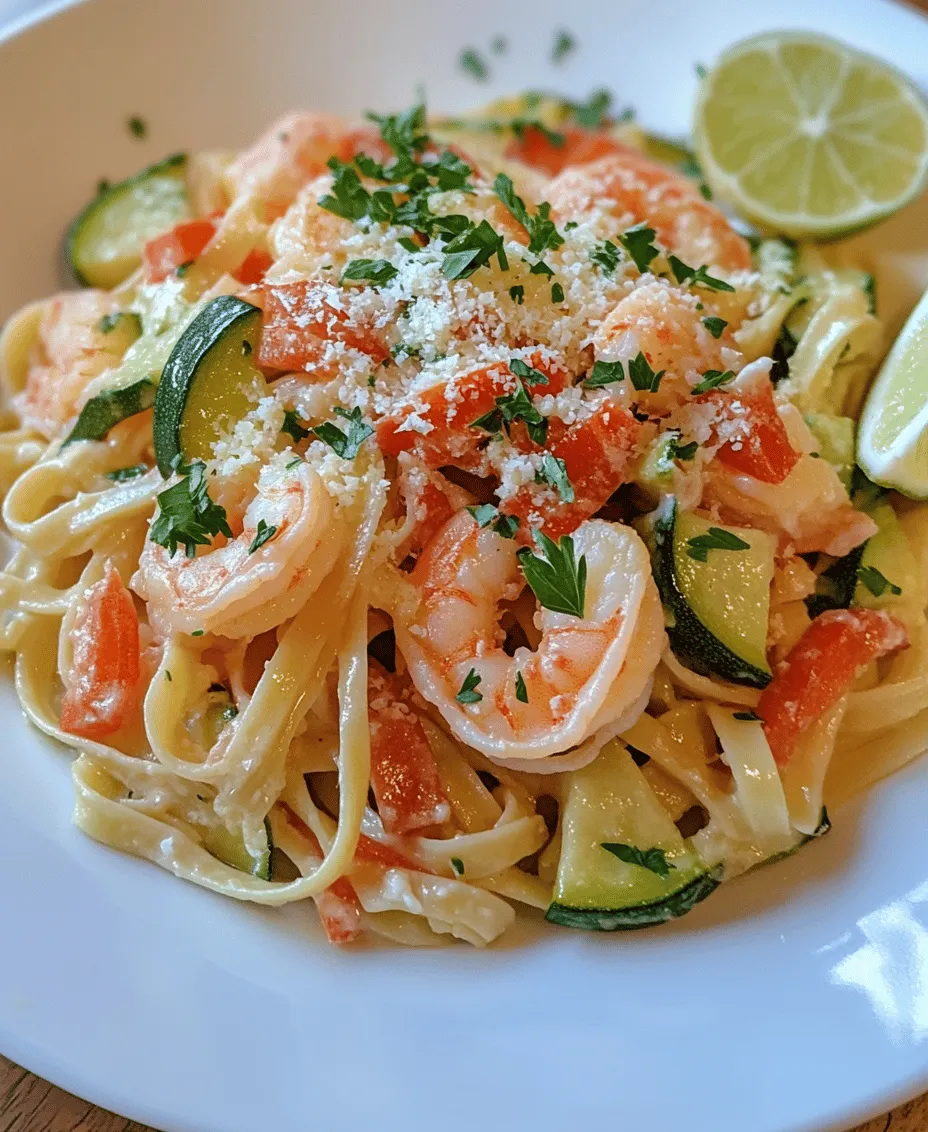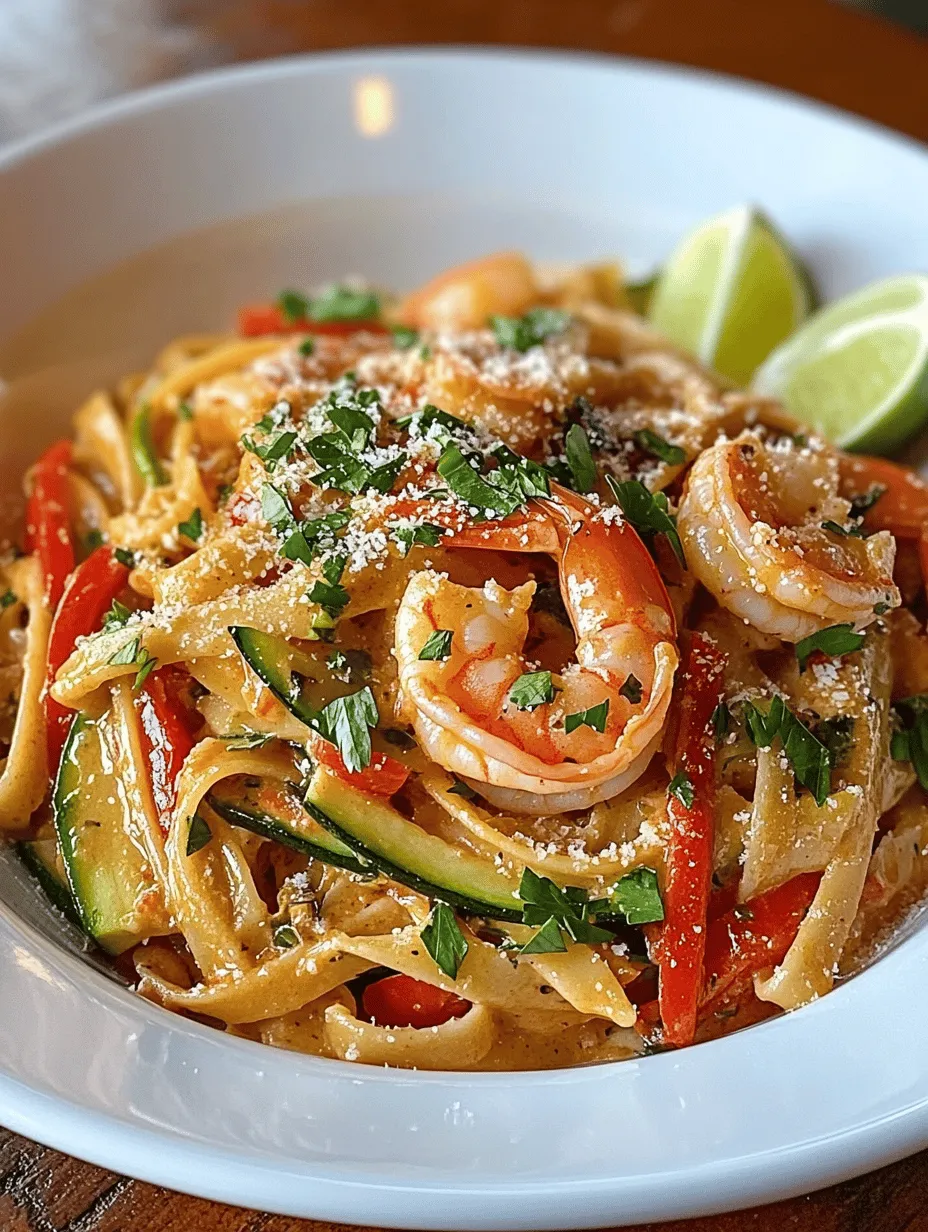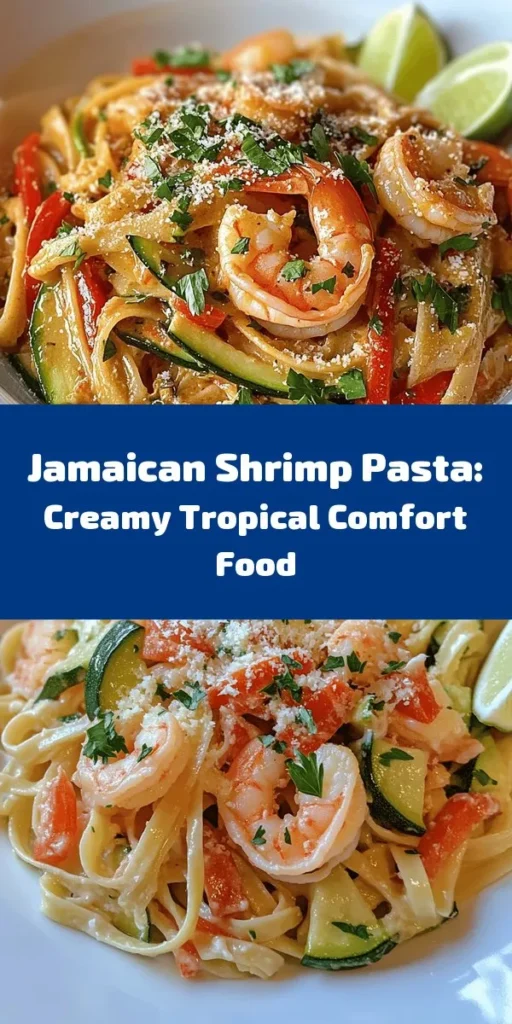Introduction
Jamaican Shrimp Pasta is a dish that encapsulates the vibrant essence of Caribbean cuisine, blending the freshness of seafood with the warmth of tropical spices. This creamy delight not only serves as an indulgent meal but also as a celebration of flavors that transport you straight to the shores of Jamaica. The dish is characterized by its rich and velvety sauce, made with coconut milk and heavy cream, enveloping perfectly cooked fettuccine and succulent shrimp, creating a harmonious balance of textures and tastes.
The appeal of Jamaican Shrimp Pasta extends beyond its delicious flavor profile; it is a versatile dish suitable for various occasions. Whether you are preparing a quick weeknight dinner for the family or hosting a special gathering with friends, this recipe is sure to impress. The combination of fresh ingredients and bold spices makes it a crowd-pleaser that can easily adapt to suit different palates.
Exploring Jamaican Cuisine
To truly appreciate Jamaican Shrimp Pasta, it’s essential to delve into the rich culinary traditions of Jamaica. Jamaican cuisine is a vibrant tapestry woven from African, Spanish, British, Indian, and Chinese influences, resulting in a unique and diverse food culture. The use of fresh, local ingredients is a cornerstone of Jamaican cooking, with an emphasis on fruits, vegetables, and seafood that reflect the island’s bountiful nature.
Spices play a pivotal role in Jamaican dishes, with jerk seasoning being one of the most iconic. This blend of spices, typically including allspice, thyme, Scotch bonnet peppers, and garlic, is used to marinate meats and seafood, imparting a distinct flavor that is both smoky and spicy. The jerk method of cooking originated from the Maroons, enslaved Africans who escaped to the mountains and developed their own cooking techniques using the resources available in the wild. Today, jerk seasoning is celebrated worldwide and can be adjusted to suit individual tastes, making it a versatile addition to many recipes.
Ingredient Breakdown
Fettuccine Pasta
At the heart of Jamaican Shrimp Pasta lies the fettuccine, a type of pasta known for its broad, flat shape, which allows it to hold onto sauces beautifully. While fettuccine is the traditional choice for this dish, there are other pasta varieties that work well, such as linguine or penne. Each type offers a unique texture that can enhance the overall dining experience.
When it comes to nutritional information, fettuccine is typically made from refined wheat, which provides carbohydrates necessary for energy. For those seeking a healthier alternative, whole wheat or gluten-free pasta can be used without compromising the dish’s integrity. Cooking the pasta to an al dente texture is essential; it ensures that the noodles maintain a slight bite and don’t become mushy when combined with the creamy sauce.
Shrimp
The star of the show is undoubtedly the shrimp. Fresh, high-quality shrimp is crucial for achieving the best flavor and texture in this dish. When selecting shrimp, look for varieties that are firm, translucent, and have a mild, briny scent. Avoid shrimp that appear dull or have a strong odor, as these are indicators of poor quality.
In addition to being delicious, shrimp offers numerous health benefits. It is a lean source of protein, low in calories, and packed with essential nutrients such as omega-3 fatty acids, selenium, and vitamin B12. Including seafood in your diet contributes to heart health and supports brain function, making shrimp a great addition to a balanced meal.
Vegetables
To add color, nutrition, and texture to the dish, bell peppers and zucchini are included. Bell peppers provide a sweet crunch, while zucchini adds a subtle earthy flavor that complements the shrimp and pasta perfectly. Together, these vegetables not only enhance the dish’s visual appeal but also contribute valuable vitamins and minerals.
For a seasonal twist, consider substituting these vegetables with other options like asparagus, cherry tomatoes, or spinach, depending on what is fresh and available. Seasonal vegetables can elevate the dish further and provide a delightful variety of flavors.
Coconut Milk and Heavy Cream
The creamy sauce that envelops the pasta is achieved through a combination of coconut milk and heavy cream. Coconut milk imparts a rich, tropical flavor that pairs wonderfully with the spices and seafood, while heavy cream adds an indulgent richness that makes each bite divine. This combination creates a luxurious texture that is both comforting and satisfying.
For those looking for a lighter version of the dish, alternative dairy options can be used. Coconut cream can replace heavy cream to keep the dish dairy-free while maintaining its lush consistency. Additionally, for a lower-calorie option, unsweetened almond milk or oat milk can be used, although the flavor and creaminess may vary slightly.
Jerk Seasoning
No Jamaican dish would be complete without the bold flavors of jerk seasoning. This spice blend is a celebration of the Caribbean’s culinary heritage, typically consisting of a mix of allspice, thyme, scallions, garlic, and Scotch bonnet peppers. The result is a complex flavor profile that is both spicy and aromatic, infusing the shrimp and pasta with an unmistakable Jamaican flair.
When using jerk seasoning, it’s important to adjust the spice levels according to your preference. If you are sensitive to heat, consider using a milder version of the seasoning or reducing the amount used in the recipe. Conversely, if you enjoy a bit of heat, feel free to amp up the spices for a fiery kick.
Step-by-Step Cooking Instructions
Cooking the Pasta
To begin crafting this delightful Jamaican Shrimp Pasta, start by cooking the fettuccine. Bring a large pot of salted water to a rolling boil. Adding salt to the water enhances the flavor of the pasta, ensuring that each strand is seasoned perfectly. Once the water is boiling, add the fettuccine and cook according to the package instructions, typically around 8-10 minutes.
To achieve that perfect al dente texture, taste the pasta a minute or two before the recommended cooking time is up. You want the pasta to be firm to the bite but not hard. Once cooked to perfection, reserve a cup of the pasta water and drain the rest. The reserved pasta water can be a valuable addition to the sauce later, helping to achieve the desired consistency.
Sautéing the Shrimp and Vegetables
In a large skillet, heat a splash of olive oil over medium-high heat. Once the oil is shimmering, add the shrimp in a single layer, making sure not to overcrowd the pan. Cook for about 2-3 minutes on one side until they turn pink and opaque. Flip the shrimp over to cook the other side for an additional 2 minutes. Remove the shrimp from the skillet and set aside.
In the same skillet, add the sliced bell peppers and zucchini. Sauté the vegetables for about 3-4 minutes, or until they are tender but still retain some crunch. The vibrant colors of the vegetables will brighten the dish and enhance its nutritional value.
With this foundational preparation, you are well on your way to creating a Jamaican Shrimp Pasta that is not only delicious but also a testament to the rich flavors of Caribbean cuisine. Stay tuned for the next steps, where we will combine all these elements into a creamy, flavorful dish that will surely become a favorite in your kitchen.

Tips for Reserving Pasta Water for Sauce Adjustments
When cooking pasta, one of the essential techniques to ensure your sauce has the perfect consistency is to reserve some pasta water before draining. This starchy water can be used to adjust the sauce’s thickness, enhancing its creaminess without diluting the flavor. Here’s how to efficiently reserve pasta water:
1. Timing: Before you drain the pasta, use a ladle or cup to scoop out about 1 to 2 cups of the cooking water. It’s better to reserve more than you think you’ll need, as you can always add it gradually to the sauce.
2. Storage: Keep the reserved water in a bowl or pot, covered, until you’re ready to combine it with the sauce. It can easily cool down, so it’s advisable to do this right before you finish cooking the pasta.
By following these steps, you ensure that you have the perfect ingredient on hand to help you achieve an ideal sauce consistency.
Sautéing the Aromatics
The foundation of a delicious Jamaican Shrimp Pasta lies in the aromatics. Sautéing onions and garlic not only builds flavor but also sets the stage for the entire dish. Here’s how to do it effectively:
1. Choosing Your Ingredients: Use finely chopped yellow onions and minced garlic for the best results. The sweetness of the onions complements the savory garlic.
2. Medium Heat: Start by heating a tablespoon of olive oil in a large skillet over medium heat. This temperature allows the aromatics to cook evenly without burning, which enhances their natural sweetness.
3. Sautéing Technique: Add the chopped onions first, stirring frequently for about 3-4 minutes until they become translucent. Then, add the minced garlic and continue to sauté for an additional minute. Be careful not to let the garlic brown, as it can become bitter.
This careful sautéing creates a fragrant base that will enrich the sauce and complement the shrimp and vegetables.
Cooking the Shrimp and Vegetables
Once your aromatics are ready, it’s time to cook the shrimp and vegetables, which will add protein and nutrition to your dish.
1. Perfectly Cooked Shrimp: Add the shrimp to the skillet, making sure they are evenly spaced to allow for even cooking. Cook the shrimp for about 2-3 minutes on one side until they start turning pink. Flip them over and cook for another 1-2 minutes. Be cautious not to overcook them; shrimp are done when they are opaque and firm to the touch.
2. Incorporating Vegetables: For optimal texture and flavor, consider using bell peppers, zucchini, or cherry tomatoes. Add them to the skillet after flipping the shrimp. This timing allows the vegetables to soften slightly while still retaining their crunch. Sauté everything together for an additional 3-4 minutes.
The combination of shrimp and vegetables not only enhances the dish’s nutritional profile but also adds a colorful visual appeal.
Creating the Creamy Sauce
The creamy sauce is the heart of your Jamaican Shrimp Pasta, bringing all the flavors together. Here’s how to create it:
1. Balancing Flavors: Pour in a cup of coconut milk and half a cup of heavy cream to create a rich, creamy texture. Incorporate two tablespoons of jerk seasoning to introduce a spicy, aromatic flavor that is quintessentially Jamaican.
2. Simmering for Flavor Melding: Bring the mixture to a gentle simmer, allowing the flavors to meld together. This should take about 5 minutes. Stir occasionally to prevent sticking and to ensure an even distribution of the seasonings.
As the sauce simmers, it will thicken and become luxuriously creamy, making it the ideal coating for the pasta.
Combining Pasta and Sauce
Now that your sauce is ready, it’s time to bring everything together. Properly integrating the pasta with the sauce ensures that each bite is flavorful.
1. Techniques for Integration: Add the drained pasta directly into the skillet with the creamy sauce. Use tongs or a large spoon to toss the pasta, coating it evenly with the sauce.
2. Adjusting Sauce Thickness: Gradually add the reserved pasta water, a little at a time, until you achieve your desired sauce consistency. This step is crucial; the starch in the pasta water helps the sauce adhere to the pasta, creating a cohesive dish.
Finishing Touches
To elevate your Jamaican Shrimp Pasta, add finishing touches that will brighten the flavors and enhance the presentation.
1. Lime Juice and Parsley: Squeeze the juice of half a lime into the pasta and toss in freshly chopped parsley. The acidity from the lime will brighten the dish, while the parsley adds a pop of color and freshness.
2. Optional Garnishes: Consider garnishing with sliced scallions or a sprinkle of grated Parmesan cheese for added flavor and visual appeal. These small details can make a big difference in presentation and taste.
Nutritional Information
Understanding the nutritional benefits of your Jamaican Shrimp Pasta is essential for making informed dietary choices.
1. Overview of Main Ingredients: Shrimp is a low-calorie protein source rich in vitamins and minerals, including vitamin B12 and selenium. Coconut milk adds healthy fats, while vegetables contribute fiber and essential nutrients.
2. Caloric Breakdown: A serving of Jamaican Shrimp Pasta typically contains around 500-600 calories, depending on the portion size and whether you use light or full-fat coconut milk.
3. Health Considerations: While this dish is indulgent, it can be made healthier by using fewer heavy creams or incorporating more vegetables. You can also opt for whole grain pasta for added fiber.
Serving Suggestions
To complement your Jamaican Shrimp Pasta and create a well-rounded meal, consider the following serving suggestions:
1. Side Dishes: A simple side salad with mixed greens and a citrus vinaigrette pairs beautifully, as do roasted vegetables or garlic bread for a comforting touch.
2. Beverage Pairings: Pair your dish with a light white wine, such as Sauvignon Blanc, or a refreshing cocktail like a mojito to enhance the tropical flavors of the meal.
3. Presentation Tips: Serve the pasta in large bowls, garnished with additional lime wedges and parsley for a colorful presentation. Consider using a sprinkle of red pepper flakes for an extra kick.
Conclusion
Jamaican Shrimp Pasta is a delightful fusion of creamy, spicy, and savory flavors that brings the taste of the Caribbean to your home kitchen. Its rich texture, combined with the fresh ingredients, creates a dish that is both comforting and elegant. This recipe is not only versatile—allowing for adjustments based on dietary preferences—but it also invites creativity in the kitchen.
Whether you’re cooking for a special occasion or simply craving a delicious meal, this Jamaican Shrimp Pasta is sure to impress. Explore the vibrant world of Jamaican cuisine and enjoy the journey of flavors. Embrace this culinary adventure, and let your taste buds celebrate the delightful fusion of spices and creaminess that defines this dish.



